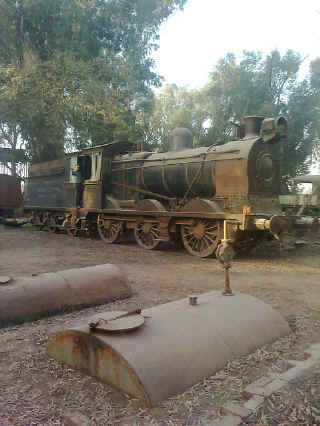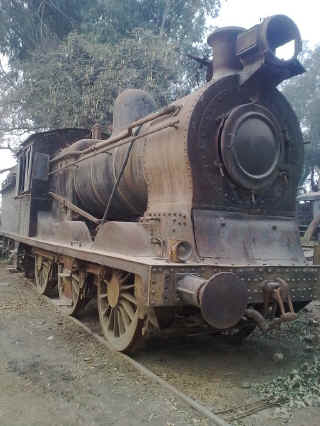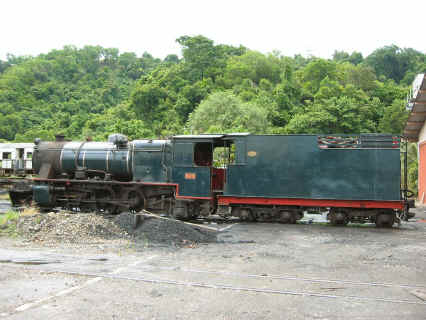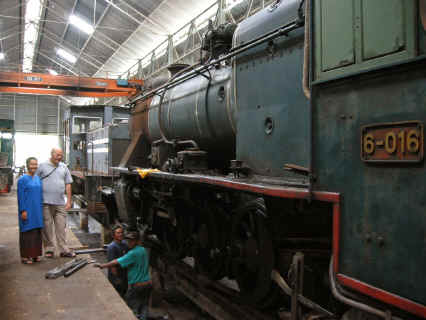Latest Vulcan Foundry Steam Survivors Photographs
|
Latest Vulcan Foundry Steam Survivors Photographs |
We are always on the lookout for photographs of the surviving locomotives for the site, this page contains the latest ones received.
Neil Thornton has taken this photograph of French State Railways 140.C.38 built by the Vulcan Foundry in 1919/20 at Thiviers in the Dordogne on Sun, 12 Jul 2015.
 |
 |
Mehboob Ahmed of Sargodha in Pakistan has sent in this photograph of 3185 built in 1916 which he has purchased from the Punjab Canal Department and now has on offer for onward sale.
Stuart Beckwith of Freighter Voyages came across the site and found it of great interest and has supplied the above photographs of the ex Victorian (Australia) J class locomotives. They are still very active with the photographs taken at Maldon on 27-06-10 and Healesville in April.
Stuart informs us that Australia like Europe had a necessity to introduce new and additional locomotives after the war and Victorian railways went to Vulcan for the J class (light passenger and branch line freight) in 1952 to 1954. At the same time the Victorian railways commissioned North British in Glasgow to build the R class being for express passenger work, In fact North British had an R class on display at the Festival of Britain. But at the same time the Victorian Railways introduced the B and S class GM diesels. The R class steam engine was redundant before the last arrived from Britain. They were moved on to freight work. The J faired slightly better but their days were numbered when the T class GM diesel was introduced in the late 50’s early 60’s to replace the K class and J class steam engines.
The K’s were made redundant in the early 60’s with the J’s soldiering on until the late 60’s mainly in the end as yard shunters. At the end of their lives some of the engines went as static displays in parks through out rural Victoria. The enthusiasts have been able to buy these engines from local municipal councils who have no interest in what so ever. Hence there is a lively preservation interest in Victoria.
Firstly J 515 and J 541 run on the Castlemaine to Maldon line. Castlemaine is a main line station on the Melbourne to Bendigo line. All this area is known as the gold fields area after the first discovery of gold in Victoria in 1853. The line runs over 19k’s to Maldon being a rural tourist town. J 541 is due to be relocated to the Yarra Valley line some time this year (2010).
The Yarra Valley line is based in the resort town of Healesville about 50 ks out of Melbourne. They have a lot of work to do in relaying the track. In places the bush fires of early last year caused extensive damage. They hope to rebuild the line to Yarra Glen within 5 years. This is approx. 10 ks. Then the big obstacle will be the rebuilding of the line from Yarra Glen to Lilydale To meet up with the Melbourne suburban system. This railway travels through the Yarra Glen wine district. The tourism potential is enormous.
Anyway I hope all of the above is of interest as the J class was the last steam engine to be introduced on Victoria’s broad gauge system. They were built to be able to be converted to the standard gauge. If you are interested two web sites that cover the above railways are www.yarravalleyrailway.org and www.vgr.com.au
Alberto Piñeiro president of the Ferroclub Chivilcoy in Argentina has sent in this photograph of locomotive 1567 built by the Vulcan Foundry in 1948 (Vulcan number 5630). The locomotive was preserved by the society in 1983, currently in fully operational condition the locomotive was in daily use up to 1981 on the General Roca Line. Alberto Piñeiro presidente del Ferroclub Chivilcoy en la Argentina ha enviado en esta fotografía de la locomotora 1567 construido por la fundición en 1948 Vulcano (Vulcan número 5630). La locomotora fue preservado por la sociedad en 1983, actualmente en pleno funcionamiento condición fue la locomotora de uso diario hasta 1981, relativo a la Línea General Roca. |
|
Chris Cork has sent in this photograph of a particularly ancient Vulcan Foundary loco now standing at a local museum after residing in the sidings at Bahawalpur where Chris lives for many years. The loco was 'rescued' by the museum a year ago and although the curator seems to know next to nothing about it but they do have funds for some restoration work. Originally built for the Bengal Nagpur Railway in 1902 the loco was apparently used on a railway specially constructed to build the headworks of the Abbasi canal in Punjab in the early part of the last century. Hussain Ahmad Madni the Director/Curator of the Bahawalpur Museum has asked if anyone has any technical and/or historical information about this Indian broad gauge locomotive (builders number 1834) that would aid it's restoration. The museum is also struggling to identify help, expertise and facilities to help them return this well preserved locomotive to as near original condition as possible. Unfortunately I have very little material covering the time period 1890-1920 and it would be wonderful if someone could help the museum with their request. Please contact me if you can help or you would like your details forwarded to the museum. |
|
David Oxlade sent in this photograph of 2 Vulcan Foundary locos working together as they retired for the evening at the keighley and Worth valley Railway on the 22nd July 2007. |
|
Asger Christiansen sent in this photograph of Vulcan built Chinese 4-8-4 KF Class of 1935 vintage taken in May/June of 2007 at Beijing Railway Museum. |
|
Tramwaw.fun from Poland has sent this photograph in of one of the 1946 Vulcan built Liberation Class Locomotives Works Number 5448 at the Rail and Industry Museum in Jaworzyna Slaska ,Poland in September 1999. |
|
Mike Joyce
has sent this photograph in of one of the three Vulcan built wood burning
locomotives supplied to the North Borneo Railway in 1955 these non-fossil fuel
'Carbon Neutral Locomotives' built over 50 years ago are still working today. |
Dennis Hewitt of the Derwent Valley Railway in Tasmania has sent in the above photographs of the remaining H Class Mountain Locomotives (based on the Nigerian River Class) superb locomotives of which H5 is of particular importance for the future and sadly currently under threat. The Derwent Valley Railway are currently running an appeal in a race against time to save this Locomotive and will greatly appreciate any donations however small to their cause.
Jose Manuel Fuentes has
kindly sent in this photograph taken in November 2006 of a 1926 Vulcan built 12E
(#3913) formerly
operated by the Buenos Aires Great Southern Railway (BAGSR) and now languishing
in a park in Bahia Blanca, Argentina.
PAX now Vulcan at
Darley Dale, was a mongrel when built from two loco's PAX & Vulcan in the
1950's.
The original donors were a matched pair built in 1918.
Photo Supplied by Brian Orrell
Andrew White has sent in this photograph of Josephine he took whilst on Holiday in New Zealand.
Josephine was built and shipped to New Zealand in 1872 for the Dunedin & Port Chalmers Railway along with sister loco Rose.
Thomas Lacey has spotted ex ISR and Pakistan Railways 4-4-0 at the Manchester Museum of Science & Industry.
If the number is correct it's Broad Gauge and built in (or possibly paid for) 1914.
 |
 |
These photo's are a first for the site and have been kindly supplied by Graham Jones.
Graham says; 'Just arrived back from Borneo where I visited the North Borneo Railway (NBR). At the start of the millennium they reintroduced 2 steam engines that had bee stored for 30 years. Using your site, I identified them as the last but one steam batch ever produced, sent to the NBR, they must be some of the last wood burning engines in use and are pictured at their shed in June 2005. The locos had been stored at the North Borneo railway since 1971 when it went over to diesel. In 2000 they started to run excursions twice a week for tourists and two are in use and one has been cannibalised to keep the others running. The one in the shed is undergoing overhaul after its first five years of service and they reckon to be able to keep them running.'
Graham is currently writing an article for Steam Railway magazine and retains copyright to these photographs.
The Vulcan built 3 Locomotives for North Borneo Railways and these locomotives were the last steam order built entirely at the Vulcan Foundry in Newton-le-Willows in 1955.